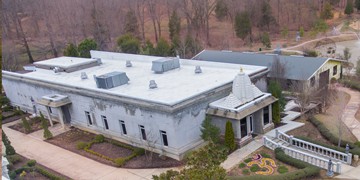
Click on the tab to view Deity details.
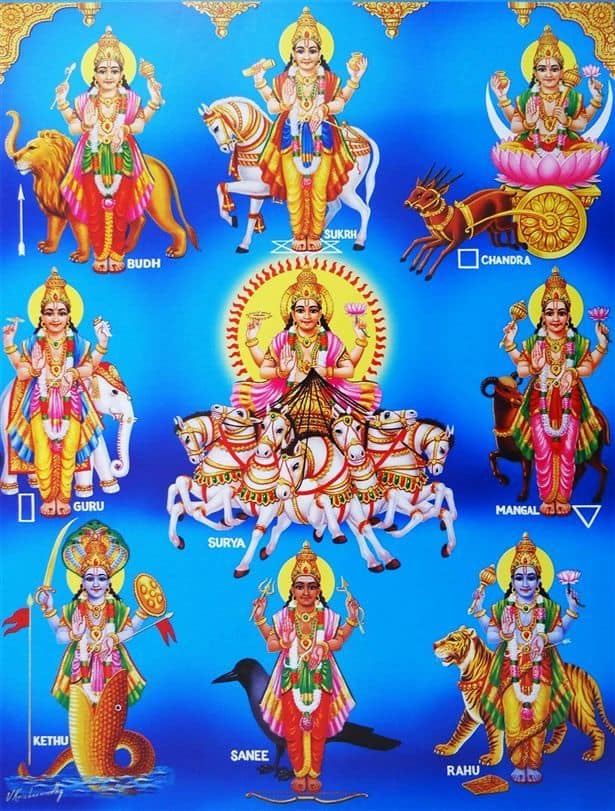 Introduction: Invoking the Lord in the form of planetary deities is one of the unique forms of worshipping God seen in the Vedic culture. The planetary deities are perceived as playing a signifi cant role in the life of an individual. Specifi c prayers are off ered to God who is invoked in the form of various planetary deities called grahas.
Introduction: Invoking the Lord in the form of planetary deities is one of the unique forms of worshipping God seen in the Vedic culture. The planetary deities are perceived as playing a signifi cant role in the life of an individual. Specifi c prayers are off ered to God who is invoked in the form of various planetary deities called grahas.NAVAGRAHA DEVATAS:
SURYA DEVATA –
THE SUN GOD Because the sun’s essential nature is light, it is called the atmakaraka or the presiding deity of the atma. The sun governs a person’s confi dence, authority, and status. The sun is also the presiding deity of the eyes and rules the sign Leo. The Visnu Purana (2.8.15) states that the sun does not move; nor does it rise or set. Rising and setting imply appearance and disappearance.
CHANDRA DEVATA-
THE MOON GOD The moon is the presiding deity of the mind and emotions. This devata is depicted with crescent moon/ holding lotus buds in his hands. He rules the sign of Cancer.
KUJA DEVATA –
THE MARS GOD The deity Kuja is also known as Mangala or Angaraka. In the Puranas he is also described as Karttikeya, the son of Lord Siva and Goddess Uma. He is depicted as wearing red clothes and carrying a spear. He governs the qualities of courage and bravery, and presides over siblings and health. He rules Aries and Scorpio.
BUDHA DEVATA –
THE MERCURY GOD Budha is the deity who presides over intelligence. He governs a person’s teaching capacities. He is depicted as holding the Vedas in one hand and a sword, a mace, and a shield in his other hands. He rules Gemini and Virgo.
GURU DEVATA –
THE JUPITER GOD Guru is the presiding deity of religious inclinations and prosperity. He is also the presiding deity of married life for women. He is described in the Puranas as Brhaspati, the preceptor of the devatas. He is often depicted in a standing posture with four hands, in one of which he holds a weapon called the vajra- ayudha. He rules Sagittarius and Pisces.
SUKRA DEVATA –
THE VENUS GOD Sukra is the presiding deity of material comforts, arts, culture, and aesthetics. He is also the presiding deity of love and married life for men. In the Puranas he is depicted as being the preceptor of King Bali. Sukra is depicted as standing with his hands folded. He is the ruler of Taurus and Libra.
SANI DEVATA –
THE SATURN GOD Sani is the presiding deity of longevity, calamities, and diffi culties in life, and, at the same time, of renunciation and spiritual wisdom. He presides over painful experiences and inner growth. In the Puranas, he is considered the son of the Sun God. He is depicted with a dark complexion, bearing a mace, and moving at a slow pace. He has a crow as his vehicle. His eyes are generally blindfolded because of the belief that his glance is very powerful and may bring misfortune. He rules Capricorn and Aquarius.
RAHU AND KETU DEVATAS –
THE RAHU GOD AND THE KETU GOD Rahu is the presiding deity of worldly desires and Ketu is the presiding deity of moksa, or freedom from limitations. Astronomically, they are not planets but the northern andsouthern nodal points of the moon. They are closely connected to each other astrologically. Mythologically, they are born of a raksasa (demon). The upper half of Rahu’s body is similar to a man, while the lower half is like a snake. Conversely, the upper half of Ketu’s body is similar to the head of a snake, while the lower half is like a man. They do not rule any signs but give the effects of the ruler of the signs where they are situated.
Navagraha’s are availed in MCP building Before leaving the temple, one offers prayers to these deities by circumambulating nine times around the altar, while chanting the Navagraha Storm or the following prayer.
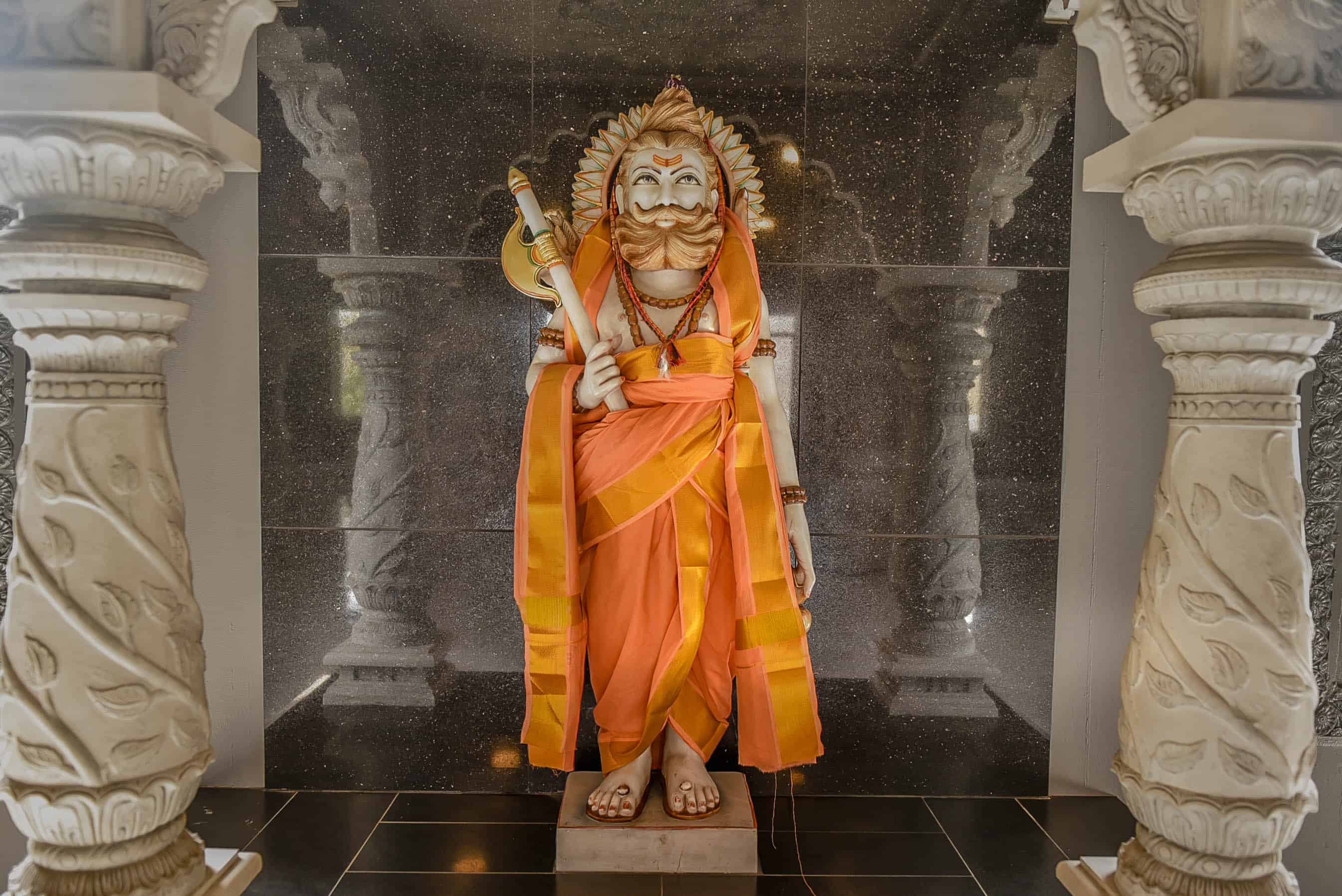 In Parasurama Avatar, Lord Vishnu incarnates himself as a brahmana(priest) in this world. He was brought in this world to avenge all kshatriyas who had become arrogant and were suppressing the brahmans in the world. He was born to Jamadagni and Renuka, and belonged to the Brighu clan. Parashurama was always carrying an axe presented to him by Lord Shiva of whom he was an ardent devotee. Kartavirya a powerful king, once went to Jamadagni’s home when he was out, and after a meal, stole the Kamadhenu cow, which was supposed to give endless quantity of milk. Jamadgni was enraged and he went and killed the king and brought Kamadhenu back. On hearing this the son of the king came back and killed Jamdagni.
In Parasurama Avatar, Lord Vishnu incarnates himself as a brahmana(priest) in this world. He was brought in this world to avenge all kshatriyas who had become arrogant and were suppressing the brahmans in the world. He was born to Jamadagni and Renuka, and belonged to the Brighu clan. Parashurama was always carrying an axe presented to him by Lord Shiva of whom he was an ardent devotee. Kartavirya a powerful king, once went to Jamadagni’s home when he was out, and after a meal, stole the Kamadhenu cow, which was supposed to give endless quantity of milk. Jamadgni was enraged and he went and killed the king and brought Kamadhenu back. On hearing this the son of the king came back and killed Jamdagni.
Parasurama was enraged at this and went and avenged the death of his father by killing all kshatriyas in 21 battles. His story is story of the supremacy of brahmans over the kshatriyas.
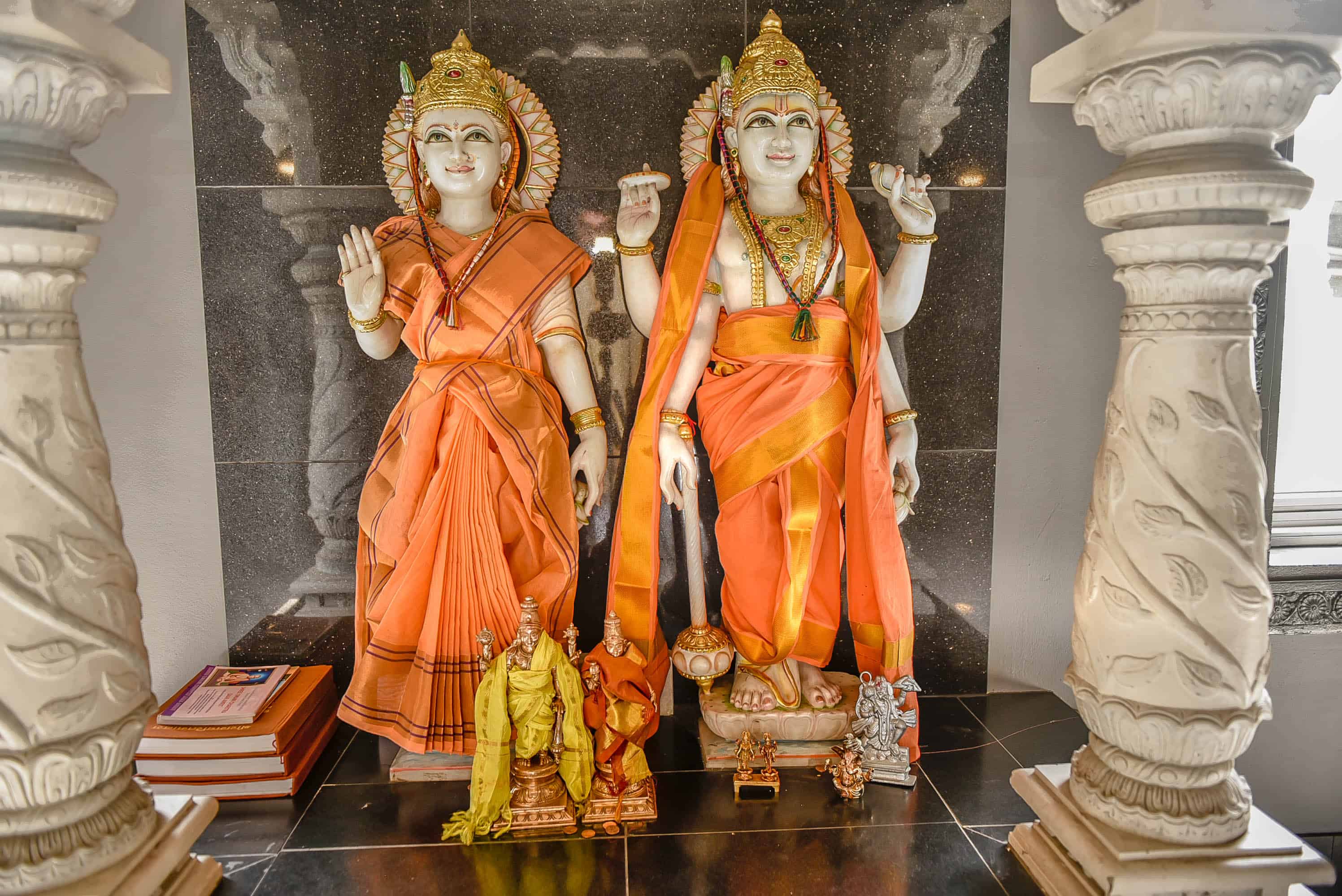 Satya means “truth” and Narayana means “The highest being” so Satyanarayan means “The highest being who is an embodiment of Truth”. The Satyanarayana Vratam and Puja are very popular throughout India. This puja is first mentioned in Skanda Purana, Reva Kanda by Suta Puranik to the rishis in Naimisharanya. The details are part of the Katha/”Story” that is usually read along with the puja.This puja is usually performed on the Purnima day of every month. It is also performed on special occasions and during times of achievements as an offering of gratitude to the Lord. These occasions could include marriage, graduation, start of a new job, and the purchase of a new home to name a few. In addition, the performance of this most auspicious puja generally confers a child to couples trying to start a family.
Satya means “truth” and Narayana means “The highest being” so Satyanarayan means “The highest being who is an embodiment of Truth”. The Satyanarayana Vratam and Puja are very popular throughout India. This puja is first mentioned in Skanda Purana, Reva Kanda by Suta Puranik to the rishis in Naimisharanya. The details are part of the Katha/”Story” that is usually read along with the puja.This puja is usually performed on the Purnima day of every month. It is also performed on special occasions and during times of achievements as an offering of gratitude to the Lord. These occasions could include marriage, graduation, start of a new job, and the purchase of a new home to name a few. In addition, the performance of this most auspicious puja generally confers a child to couples trying to start a family.
We conduct Samuhika Satynarayana Vratams at our temple on Karthika Pournami Full-moon day. All Hindu religious festivals are celebrated and large number of devotees participate regularly.
Holy Places : Annavaram , AP
Festivals : Karthika Pournami
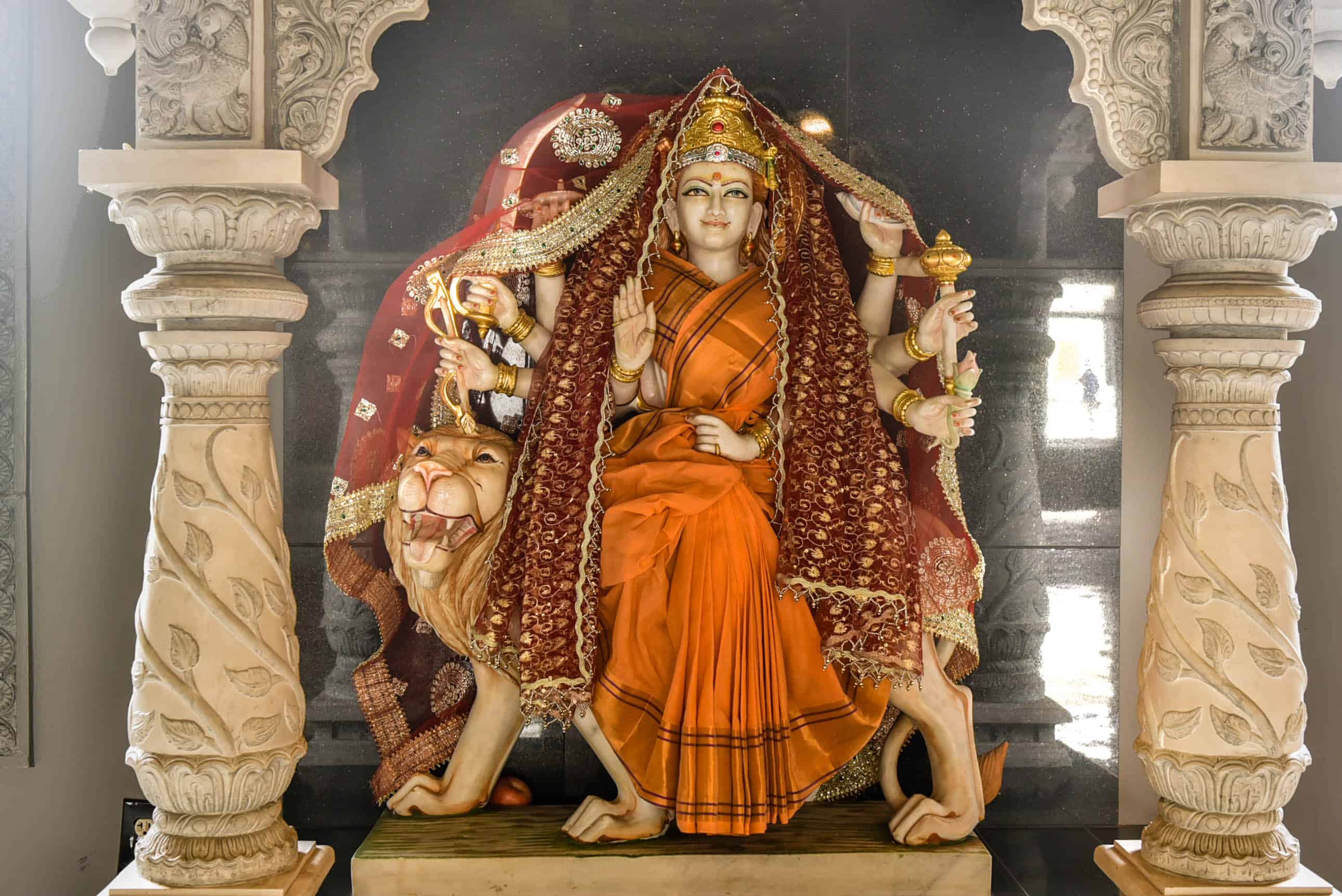 Devi Durga in Hinduism is worshiped in different forms and considered a form of Shakti. There are different reincarnations of Durga include Shakti, Kali, Gauri, Uma, Parvati, Chandi, Ambika, Lalita, Bhavani, Bhagvati, Rajeshwari and other forms. The name “Durga” means the ‘invincible’ in Sanskrit. Devi Durga symbolizes freedom from all evils. The word Durga embodies freedom from all evils like injustice, cruelty, hatred, ego and other forms of pain and suffering. All the forms of Durga are worshipped in India. The weapons held by Durga are given to her by each of the Gods and symbolize the culmination of all the divine powers in her – Shiva’s trident or ‘trishul’, Vishnu’s discus or ‘Sudarshana chakra’, Brahma’s Kamandalu, Indra’s thunderbolt, Kuber’s Ratnahar and other weapons given by different Gods.
Devi Durga in Hinduism is worshiped in different forms and considered a form of Shakti. There are different reincarnations of Durga include Shakti, Kali, Gauri, Uma, Parvati, Chandi, Ambika, Lalita, Bhavani, Bhagvati, Rajeshwari and other forms. The name “Durga” means the ‘invincible’ in Sanskrit. Devi Durga symbolizes freedom from all evils. The word Durga embodies freedom from all evils like injustice, cruelty, hatred, ego and other forms of pain and suffering. All the forms of Durga are worshipped in India. The weapons held by Durga are given to her by each of the Gods and symbolize the culmination of all the divine powers in her – Shiva’s trident or ‘trishul’, Vishnu’s discus or ‘Sudarshana chakra’, Brahma’s Kamandalu, Indra’s thunderbolt, Kuber’s Ratnahar and other weapons given by different Gods.
Festivals : Navaratri
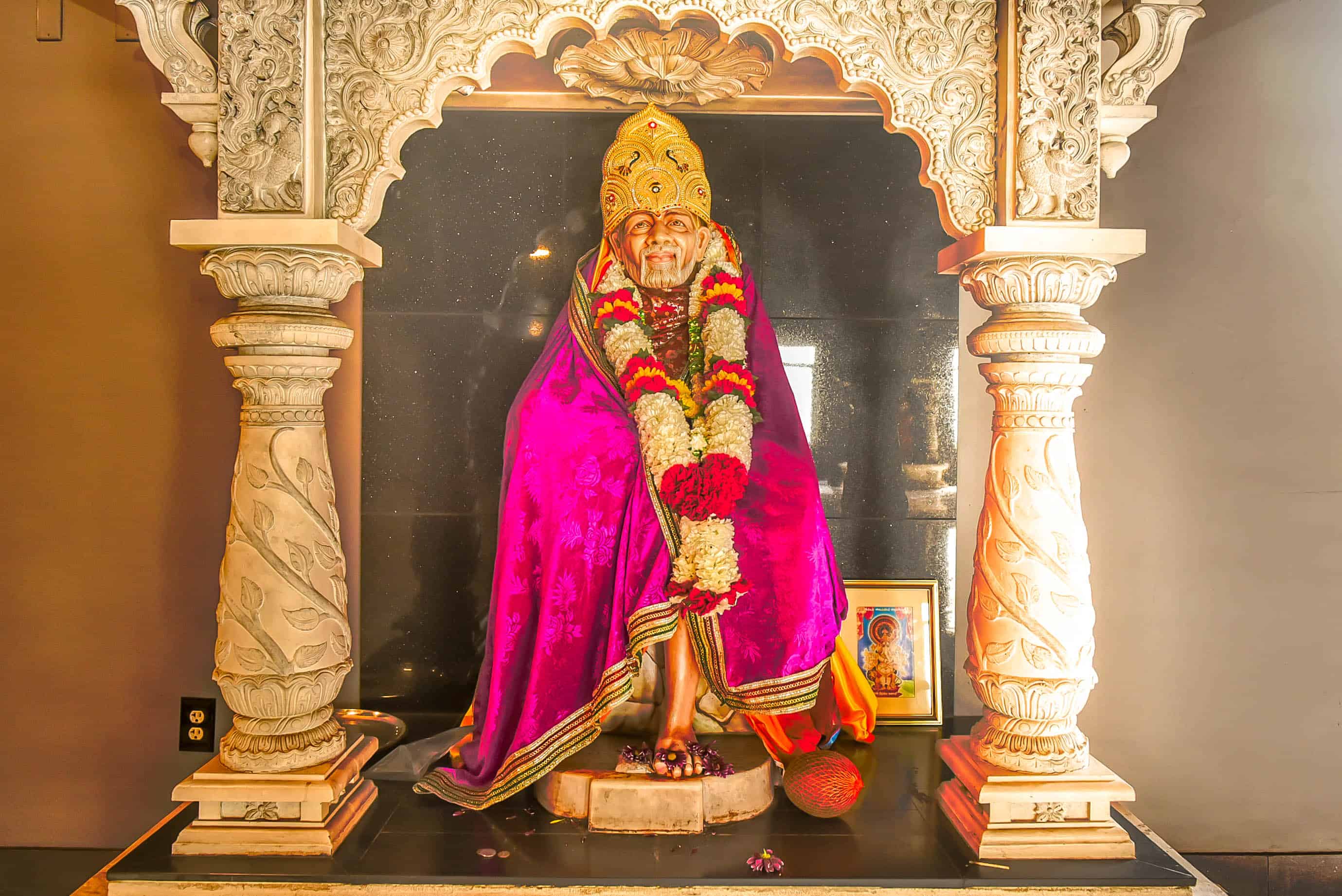 Sai Baba, one of the foremost sadgurus of India, lived in Shirdi for 60 years and elevated it to the status of a great spiritual center. Baba’s gospel that He taught by example is that religious and communal differences are meaningless in matters of the spirit. He was the embodiment of dispassion, purity and simplicity and was an enigma to all. None knew His caste, creed or parentage and neither did He think it was important to reveal it. He taught the unity of all religions and the universality of Spirit in all existence. His method of teaching was through direct experience. We urge our readers who are new to the Sai Philosophy to read Sai Satcharitra – the wonderful life and teachings of the supreme master of our age. He taught a moral code of love, forgiveness, helping others,charity, contentment, inner peace, and devotion to God and guru. He showed no distinction based on religion or caste.
Sai Baba, one of the foremost sadgurus of India, lived in Shirdi for 60 years and elevated it to the status of a great spiritual center. Baba’s gospel that He taught by example is that religious and communal differences are meaningless in matters of the spirit. He was the embodiment of dispassion, purity and simplicity and was an enigma to all. None knew His caste, creed or parentage and neither did He think it was important to reveal it. He taught the unity of all religions and the universality of Spirit in all existence. His method of teaching was through direct experience. We urge our readers who are new to the Sai Philosophy to read Sai Satcharitra – the wonderful life and teachings of the supreme master of our age. He taught a moral code of love, forgiveness, helping others,charity, contentment, inner peace, and devotion to God and guru. He showed no distinction based on religion or caste.
Holy Places : Shiridi , MH
Festivals : Guru Pournami
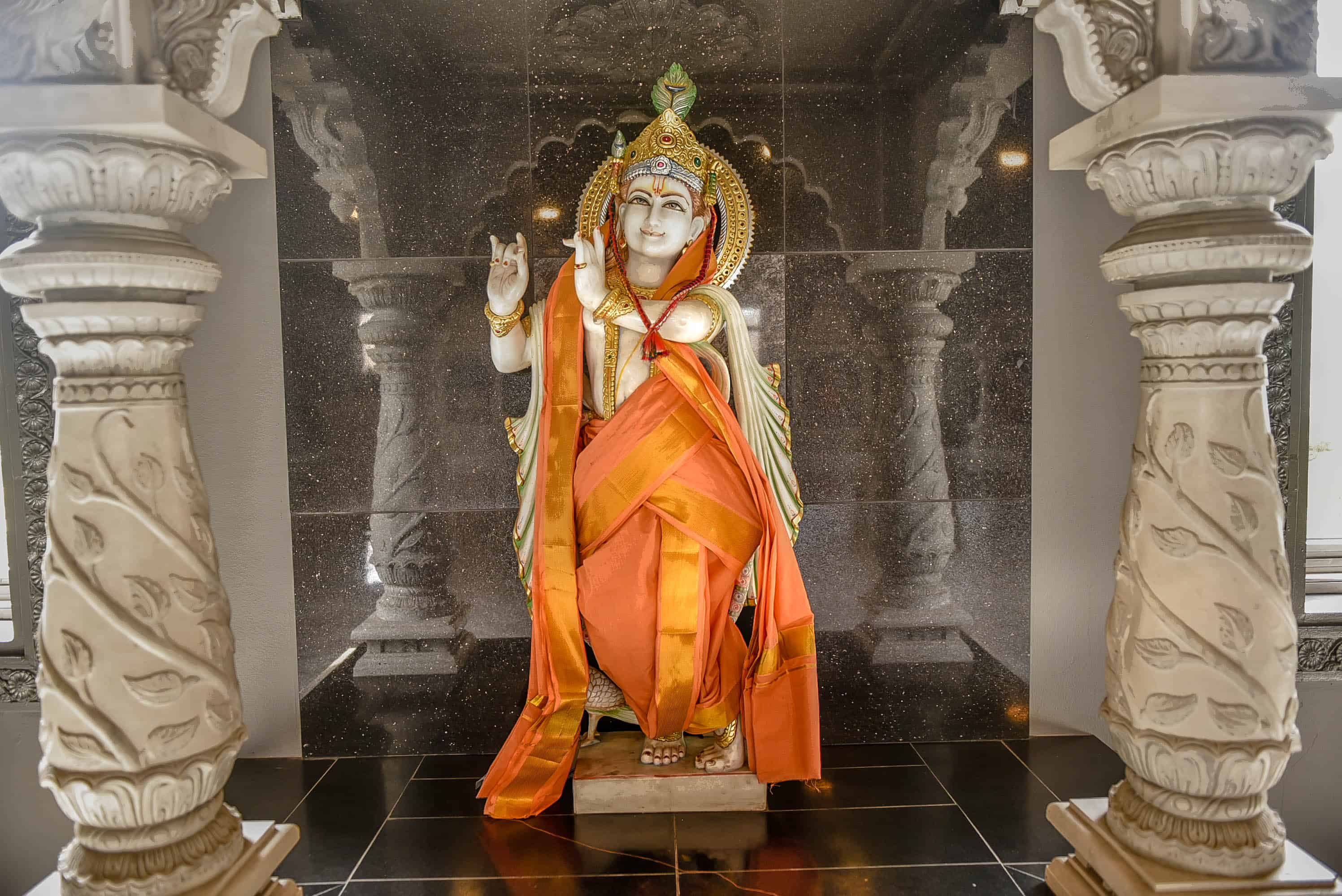 Krishna is a name of the original, unique Supreme Person, the source of all that exists. God has many names, and each describes a different aspect of His personality. Allah, Vishnu, Jehovah, and God refer to His greatness and His role as creator, maintainer of the universe, and Lord of all. The name Krishna-“the all-attractive one”-indicates the unequaled charm and beauty of the Supreme Person, as He appears to His most dear devotees.
Krishna is a name of the original, unique Supreme Person, the source of all that exists. God has many names, and each describes a different aspect of His personality. Allah, Vishnu, Jehovah, and God refer to His greatness and His role as creator, maintainer of the universe, and Lord of all. The name Krishna-“the all-attractive one”-indicates the unequaled charm and beauty of the Supreme Person, as He appears to His most dear devotees.
Krishna appears as other forms of God avatars to create and maintain the universe, while He simultaneously enjoys loving relationships with His countless associates in the spiritual world. He visits this material world from time to time to free His devotees from material existence and to vanquish the wicked. Krishna appears in many stories in different forms. Sometimes he is a child. Sometimes he’s a flute-player who calls people’s souls. Other times he is involved in love affairs with Hindu goddesses, or he’s a great leader.Krishna’s most famous story is in the Bhagavad Gita, written about 300 BC. In the Bhagavad Gita, Krishna is disguised as a charioteer. He tells the young prince Arjuna how to act according to his dharma, and generally what is good and what is bad.
Holy Places : Mathura, Udupi, Guruvayoor
Festivals : Krishnastami
 Shri Dattatreya is a very ancient incarnation, highly venerated through the ages. Dattatreya – a Universal Gurumanifested in the recess of time of ‘Kaliyug’, when humanity had gone far from its pristine state and steeped into threshold of a time when all kinds of vices had already taken root, and the pious souls made fervent appealed for the salvage of the mankind surging forward in manifold way. He had descended on this earth to establish ‘Satya’ (the Universal Truth), ‘Rta’ (the Cosmic Order), Dharma’, (the perennial principles), in all its entirety. To him was born a son, the product of the Grace or the Divine Will, which was the manifestation of all three Primal Energies of Brahma, Vishnu and Shiva. He was ordained with the three energies; He came to have the concentrated wisdom of the three God-heads or symbolically three heads. The three heads signified as Brahma: ‘Tejas’ personified, Vishnu: ‘Ojas’ personified, Shiva: ‘Tapas’ personified. Under these heads, illumination of knowledge, vigorosity of action and stringency of penance were represented as three aspects or state of being of the same.
Shri Dattatreya is a very ancient incarnation, highly venerated through the ages. Dattatreya – a Universal Gurumanifested in the recess of time of ‘Kaliyug’, when humanity had gone far from its pristine state and steeped into threshold of a time when all kinds of vices had already taken root, and the pious souls made fervent appealed for the salvage of the mankind surging forward in manifold way. He had descended on this earth to establish ‘Satya’ (the Universal Truth), ‘Rta’ (the Cosmic Order), Dharma’, (the perennial principles), in all its entirety. To him was born a son, the product of the Grace or the Divine Will, which was the manifestation of all three Primal Energies of Brahma, Vishnu and Shiva. He was ordained with the three energies; He came to have the concentrated wisdom of the three God-heads or symbolically three heads. The three heads signified as Brahma: ‘Tejas’ personified, Vishnu: ‘Ojas’ personified, Shiva: ‘Tapas’ personified. Under these heads, illumination of knowledge, vigorosity of action and stringency of penance were represented as three aspects or state of being of the same.
Festivals : Datta Jayanthi
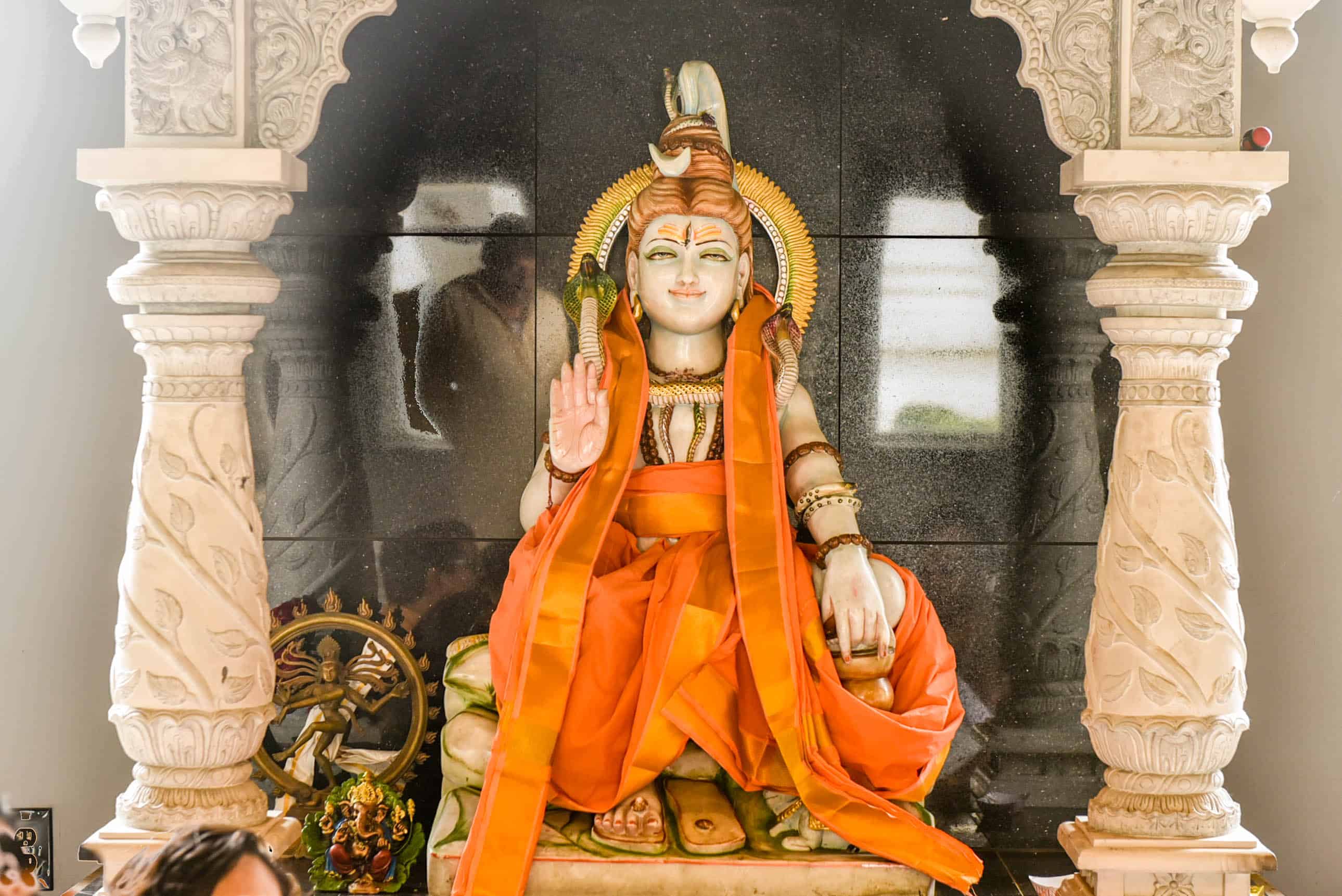 Shiva literally means “auspiciousness, welfare”. He is the third god of the Hindu Triad and he is the god of destruction. He represents darkness , and it is said to be the “angry god”.The term destruction as it relates to Shiva’s cosmic duties can be deceiving. Often Lord Shiva destroys negative presences such as evil, ignorance, and death. Also, it is the destruction created by Lord Shiva that allows for positive recreation. For example, an artisan may melt down (i.e., destroy) old pieces of metal during his process of creating a beautiful piece of art. It is for this reason that Shiva holds a complementary role to Brahma, the god of creation. Shiva protects souls until they are ready for recreation at the hands of Brahma. Because of his connections with destruction, Lord Shiva is one of the most feared and heavily worshipped deities in Hinduism. However, according to Hinduism, creation follows destruction. Therefore Shiva is also regarded as a reproductive power, which restores what has been dissolved. As one who restores, he is represented as the linga or phallus, a symbol of regeneration.
Shiva literally means “auspiciousness, welfare”. He is the third god of the Hindu Triad and he is the god of destruction. He represents darkness , and it is said to be the “angry god”.The term destruction as it relates to Shiva’s cosmic duties can be deceiving. Often Lord Shiva destroys negative presences such as evil, ignorance, and death. Also, it is the destruction created by Lord Shiva that allows for positive recreation. For example, an artisan may melt down (i.e., destroy) old pieces of metal during his process of creating a beautiful piece of art. It is for this reason that Shiva holds a complementary role to Brahma, the god of creation. Shiva protects souls until they are ready for recreation at the hands of Brahma. Because of his connections with destruction, Lord Shiva is one of the most feared and heavily worshipped deities in Hinduism. However, according to Hinduism, creation follows destruction. Therefore Shiva is also regarded as a reproductive power, which restores what has been dissolved. As one who restores, he is represented as the linga or phallus, a symbol of regeneration.
Holy Places – There are 12 holy places known as ‘Dwadasa Jyothirlingams’. They are: Somanathan (Saurastra), Mallikarjuna (Sri Sailam), Mahakalyam (Ujjain),
Om karam (Parameshwaram), Kedarnath (Himalaya), Bhimasankaran (Dakani), Vishveswara (Varnasi), Triambakam (Goutami), Paralyam (Vaidyanath), Baidyanatham (Darukavanam), Rameshwaram (Sethu Bandan), Siva (Gasmesham)
Festivals – Maha Sivaratri, Siva Sahasra Kalasa Abhishekam, Siva Parvathi Kalyanam, Siva Annabhishekam, Shravan/Karthik Somvar.
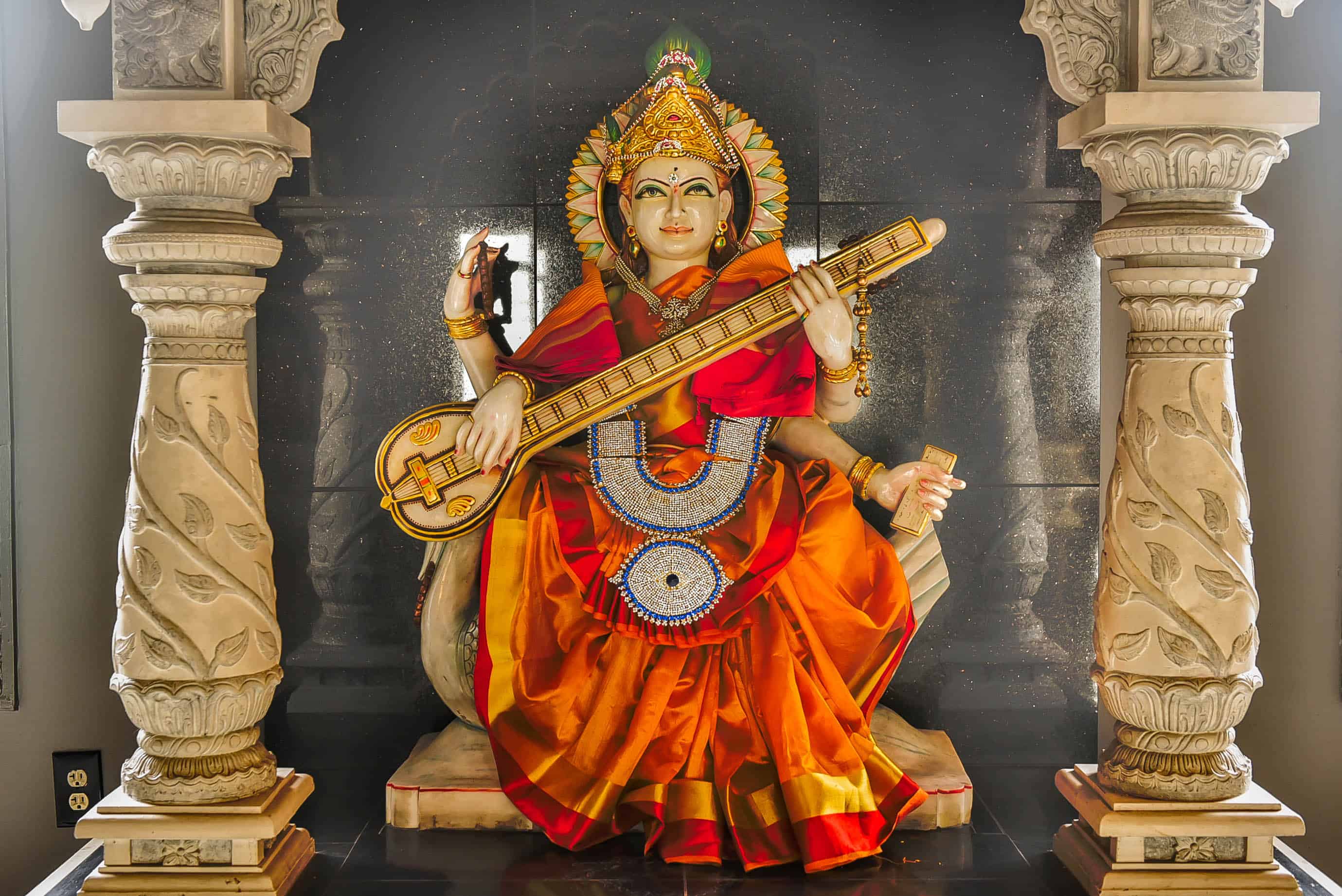 Saraswathi, goddess of knowledge and the arts, embodies the wisdom of Devi. She is the river of consciousness that enlivens creation; she is the dawn-goddess whose rays dispel the darkness of ignorance. Without her there is only chaos and confusion. To realize her one must go beyond the pleasures of the senses and rejoice in the serenity of the spirit.Saraswathi wears neither jewels or paints herself with bright colors. The white sari she adorns reflects her essential purity, her rejection of all that is base and materialistic. She transcends the cravings of the flesh and rejoices in the powers of the mind as the patron of pure wisdom. She embodies all that is pure and sublime in Nature. The four Vedas, books of universal knowledge, were her offspring. Her mount, the swan, personifies pure knowledge and her herald, the peacock, is a symbol of the arts. Schools and libraries are her temples; books, pens, all tools of the artist and musical instruments are the items used in puja to the enlightening goddess of wisdom.
Saraswathi, goddess of knowledge and the arts, embodies the wisdom of Devi. She is the river of consciousness that enlivens creation; she is the dawn-goddess whose rays dispel the darkness of ignorance. Without her there is only chaos and confusion. To realize her one must go beyond the pleasures of the senses and rejoice in the serenity of the spirit.Saraswathi wears neither jewels or paints herself with bright colors. The white sari she adorns reflects her essential purity, her rejection of all that is base and materialistic. She transcends the cravings of the flesh and rejoices in the powers of the mind as the patron of pure wisdom. She embodies all that is pure and sublime in Nature. The four Vedas, books of universal knowledge, were her offspring. Her mount, the swan, personifies pure knowledge and her herald, the peacock, is a symbol of the arts. Schools and libraries are her temples; books, pens, all tools of the artist and musical instruments are the items used in puja to the enlightening goddess of wisdom.
Holy Places : Basara , Telangana
Festivals : Vasant Panchami, Saraswathi Pooja in Navarathri
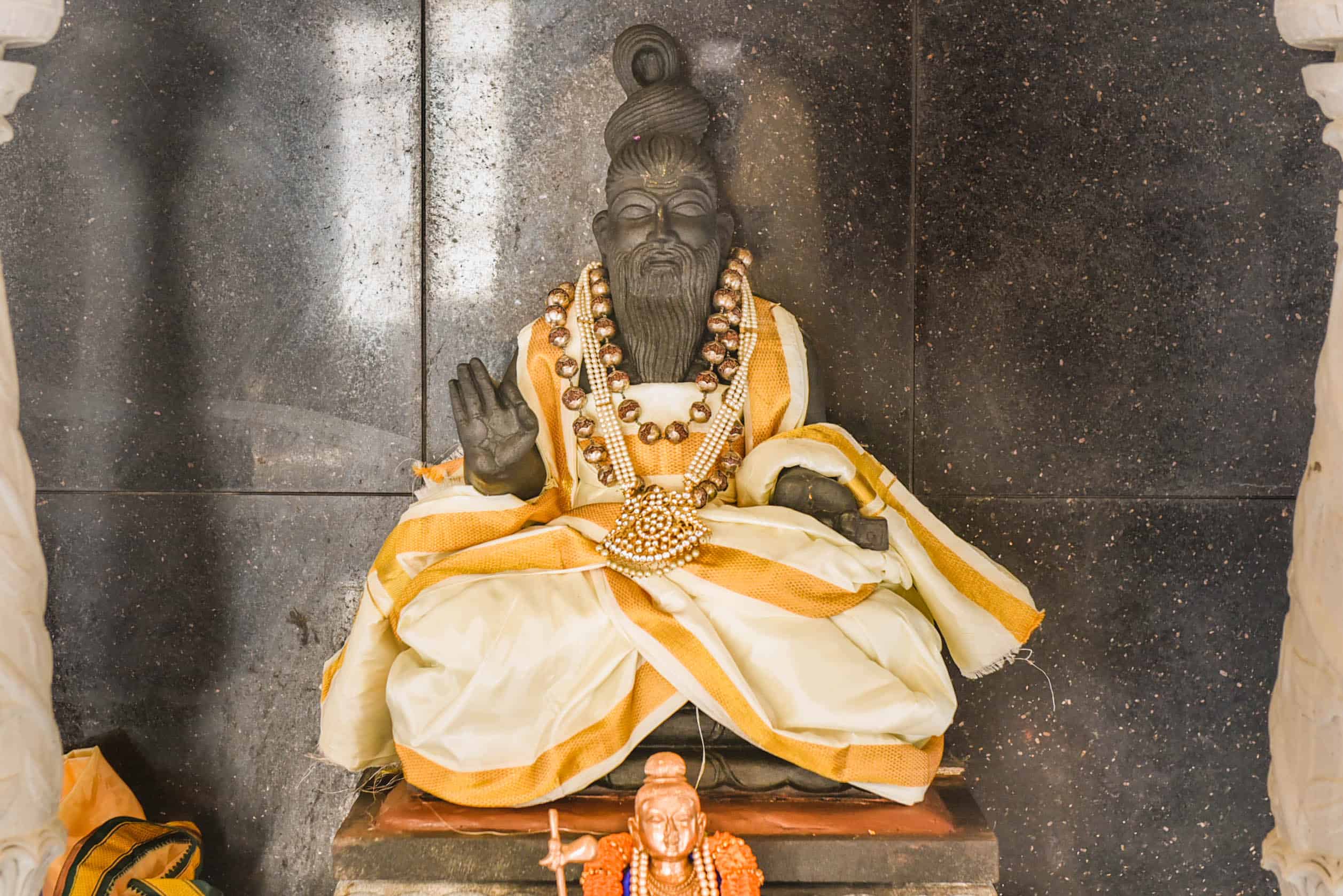 Bodhayana Maharshi
Bodhayana Maharshi